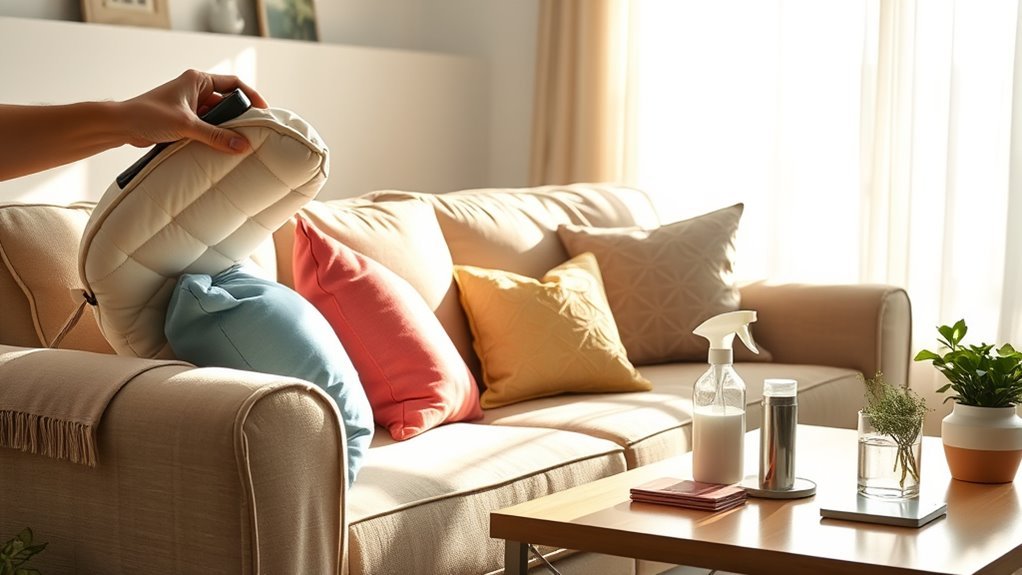Daily Maintenance Tips for Couch
You should dust and vacuum your couch weekly, focusing on seams and under cushions to prevent dirt buildup. Use a microfiber cloth or soft brush for dusting and a vacuum with adjustable suction. Blot stains gently with appropriate cleaners, testing on hidden spots first. Protect your couch from direct sunlight and pets by positioning it wisely and using barriers or grooming pets regularly. Regular checks for wear or loose threads keep it in top shape. Keep going to uncover more practical care tips.
Regular Dusting and Vacuuming Techniques

To keep your couch in top condition, you should dust and vacuum it at least once a week. Start with effective dusting techniques: use a microfiber cloth or a soft-bristle brush to lift dust from fabric and crevices without damaging fibers. Don’t forget the underarms and seams where dirt accumulates. For vacuuming tips, choose a vacuum with adjustable suction and a brush attachment to avoid fabric wear. Move the vacuum slowly over surfaces to capture embedded dust and pet hair. Remember to detach cushions and vacuum underneath to prevent hidden buildup. Regular dusting and vacuuming not only preserve your couch’s appearance but also improve your living space’s air quality, giving you the freedom to relax without worry.
Spot Cleaning and Stain Removal Methods
Dealing with stains promptly is key to preserving your couch’s fabric and appearance. Start by using stain identification techniques—recognize whether the stain is oil-based, water-based, or protein-based to choose the right treatment. For most common stains, homemade cleaning solutions work wonders. For example, a mix of white vinegar and water can tackle water-based stains, while baking soda helps absorb oils. Always test your solution on a hidden area first. When applying, blot gently—never rub—to avoid spreading the stain or damaging fibers. Use a clean cloth, working from the stain’s edges inward. After spot cleaning, let the fabric air dry completely. With these precise steps, you maintain your couch’s look without harsh chemicals, giving you the freedom to enjoy a fresh, stain-free space.
Protecting Your Couch From Sunlight and Pets

Although your couch is designed for comfort, prolonged exposure to sunlight and pets can quickly degrade its material and appearance. To shield your couch, install sunlight filters like UV-blocking curtains or blinds—these reduce fading and fabric weakening without sacrificing natural light. Positioning your couch away from direct sunlight also helps preserve its color and texture. When it comes to pets, setting up pet barriers keeps them off the furniture, preventing scratches, fur buildup, and accidental stains. Consider training your pets to use designated areas with cozy beds or blankets. Regularly grooming your pets reduces shedding, limiting the damage they can cause. By proactively managing sunlight exposure and pet access, you maintain your couch’s longevity and keep your living space inviting and free from premature wear.
Tips for Maintaining Different Couch Materials
When caring for your couch, understanding the specific needs of its material is crucial for effective maintenance. For leather care, regularly dust and wipe with a damp cloth, then condition with a leather-specific product to keep it supple and prevent cracking. Avoid harsh chemicals that strip natural oils. For fabric protection, vacuum frequently to remove dust and debris. Use a fabric-safe stain repellent to guard against spills and stains. Spot-clean promptly using mild detergent or upholstery cleaner, testing first in an inconspicuous area. Microfiber demands gentle brushing to keep fibers aligned, while velvet benefits from light steaming to lift pile. By tailoring your approach to your couch’s material, you guarantee longevity and maintain its appearance, freeing you from costly repairs or replacements down the line.
Routine Checks and Preventative Measures

Since regular upkeep can prevent minor issues from escalating, performing routine checks on your couch is essential to maintaining its condition. Start with a thorough couch inspection, looking for loose threads, sagging cushions, or frame instability. Address any small tears or wobbly legs immediately to avoid costly repairs later. Incorporate cushion fluffing into your weekly routine to maintain support and shape, preventing premature wear. Pay attention to hidden areas where dirt and debris accumulate, as these can degrade fabric and cause odors. Don’t forget to check seams and zippers, ensuring they’re intact. By consistently applying these preventative measures, you’ll extend your couch’s lifespan and enjoy a comfortable, well-kept piece of furniture that supports your active lifestyle and desire for freedom.
Frequently Asked Questions
How Often Should I Replace the Cushions on My Couch?
You should consider cushion replacement every 5 to 7 years, but it really depends on your cushion maintenance habits and how often you use your couch. Regularly fluffing and rotating cushions helps extend their life, so keep up with that to delay replacement. If you notice sagging, loss of support, or visible wear, it’s time to replace. Staying proactive with cushion maintenance lets you enjoy comfort without feeling tied down by frequent replacements.
Can Couch Covers Help Extend the Life of My Sofa?
You might wonder if couch covers really make a difference in extending your sofa’s life. The truth is, they do—couch cover benefits include excellent fabric protection from spills, pet hair, and daily wear. By shielding your sofa, covers reduce fading and stains, letting you enjoy your furniture longer without constant cleaning or repairs. Choosing the right cover means you can protect your investment while keeping your freedom to relax worry-free.
What Are the Best Cleaning Products for Leather Couches?
When cleaning your leather couch, you’ll want to use a gentle upholstery cleaner specifically designed for leather to avoid damage. After cleaning, applying a quality leather conditioner is essential—it nourishes the leather, keeps it supple, and prevents cracking. Avoid harsh chemicals or household cleaners, as they can strip natural oils. By sticking to these products, you’ll maintain your couch’s look and feel, giving you the freedom to relax without worry.
How Do I Prevent Sagging in Couch Springs?
Imagine your couch springs as the roots of a mighty tree—they need constant care to stay strong. To prevent sagging, give your cushions regular fluffing and rotation; this cushion maintenance keeps the spring support evenly distributed. Avoid sitting in the same spot daily, and consider adding a plywood board beneath cushions for extra backing. By nurturing your couch like this, you’ll enjoy lasting comfort and freedom from premature wear.
Is Professional Cleaning Necessary for All Couch Types?
You don’t always need professional cleaning for every couch type, but cleaning frequency depends on your upholstery. Delicate fabrics like silk or velvet benefit from expert care to avoid damage, while durable materials like leather or synthetic fibers can often be maintained with regular at-home cleaning. Assess your upholstery’s needs and usage; if stains or odors persist, a professional’s deep clean can extend your couch’s life and keep it looking fresh without restricting your freedom to enjoy it daily.






